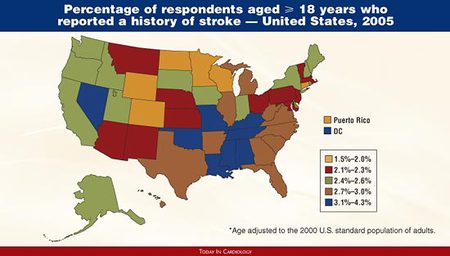Stroke prevalence differs geographically
To reduce the risk for disability and death, people should recognize signs and symptoms of stroke and promptly go to the hospital.
Stroke prevalence varies widely from state to state. Cases cluster in the southeastern states and some locations have more than double the prevalence of others, according to a Morbidity and Mortality Weekly Report.
The study “Prevalence of Stroke — United States, 2005” provides data on the percentage of stroke survivors in the nation. The findings show that stroke prevalence ranges from 1.5% in Connecticut to 4.3% in Mississippi.
“This report underscores the need of all people, especially those in disproportionately affected groups, to reduce their exposure to stroke risk factors,” said Jonathan Neyer, an epidemiologist in the CDC’s division for heart disease and stroke prevention. “Strokes are the third leading cause of death in the United States and a leading cause of serious long-term disability.”
However, stroke-related disability and death may be reduced if treatment is received in a timely manner and if people know the signs and symptoms of stroke. In a separate report published in MMWR, researchers evaluated causative factors of prehospital delays among stroke patients and which groups were most affected by delays.

“One of the first things that can be done to reduce prehospital delays is to emphasize to the public that stroke is an emergency,” said Henraya F. McGruder, PhD, epidemiologist from the division for heart disease and stroke prevention at the CDC. “Transport to a hospital by Emergency Medical Services significantly reduces wait time for stroke treatment.”
Surveying stroke nationwide
Neyer and colleagues analyzed state-specific data for people aged 18 and older collected from the 2005 Behavioral Risk Factor Surveillance System. They found substantial differences in the prevalence of stroke by state, race/ethnicity, age and education level.
Stroke prevalence was similar among men (2.7%) and women (2.5%); however, prevalence varied among different ethnic groups. American Indian/Alaska Natives had the highest prevalence (6%), and the prevalence among blacks (4%) was almost twice that of whites (2.3%). Asians had the lowest rate (1.6%).
Neyer and colleagues found that stroke prevalence increased with age; 8.1% of respondents aged older than 65 years reported a history of stroke compared with 0.8% of those aged 18 to 44 years. Stroke prevalence was more than twice as high in those with <12 years of education (4.4%) compared with college graduates (1.8%).
Although the report in MMWR did not address this issue, Neyer said that increased prevalence of stroke in certain states and among different cohorts may be attributed to differences in the prevalence of risk factors and/or disparities in social and economic factors.
“If certain states with populations of several million people can have a significantly lower prevalence of stroke than other states, then there is a significant opportunity for stroke prevention,” Neyer told Today in Cardiology. “Stroke prevention is possible. We as health professionals need to continue to limit stroke risk factors in our patients and support programs that limit tobacco use, ensure access to healthy foods and make the environment safe for and conducive to physical activity.”
|
|
Prehospital delays
McGruder and colleagues assessed prehospital delays from onset of stroke symptoms to emergency department arrival and to receipt of brain imaging. They compiled aggregate data from 142 hospitals from four states (Georgia, Illinois, Massachusetts and North Carolina) that participated in the Paul Coverdell National Acute Stroke Registry.
From Jan. 1, 2005, to Sept. 30, 2006, the researchers found that fewer than half of the people who had a stroke (48%) arrived at an ED for triage within two hours of stroke symptom onset, according to McGruder.
Of the 17,643 study participants, 53.3% were women, 75.8% were white, 19.6% were black, and 2.7% were Hispanic. Overall, 66.1% of stroke patients were aged older than 65 years. The researchers noted ischemic stroke (65.1%) as the most common stroke, followed by transient ischemic attack (24%) and hemorrhagic stroke (9.7%).
Among 7,901 patients with records of stroke symptom onset time, 48% of the patients arrived at the ED within the median arrival time of two hours. Fewer blacks (42.4%) arrived within two hours compared with whites (49.5%), and fewer non-ambulance patients (36.2%) arrived quickly compared with patients transported by ambulance (56.8%), according to the researchers.
Of those who arrived within two hours of symptom onset, 2,275 (65.2%) received imaging within one hour of arrival. Fewer women than men (62.9% vs. 67.6%) received imaging within the hour of arrival, and fewer non-ambulance patients received imaging compared with those who arrived via ambulance (56.3% vs. 69.2%). The researchers did not find any disparities among racial groups with receipt of imaging within one hour of arrival.
Lack of public knowledge about early recognition of stroke is one factor that contributes to prehospital delays, according to McGruder. It is important to stress to patients the importance of quick transportation to the hospital as soon as stroke symptoms are experienced. Based on these results, McGruder suggested that increased emphasis be placed on the importance of EMS or ambulance use among minority populations, specifically blacks.
“Life-saving therapies can only be administered if stroke patients are seen at the hospital within three hours of symptom onset,” she said. – by Tara Grassia
For more information:
- CDC. Pre-hospital and hospital delays after stroke onset — United States, 2005-2006. MMWR. 2007;56:474-478.
- CDC. Prevalence of stroke — United States, 2005. MMWR. 2007;56:469-474.

